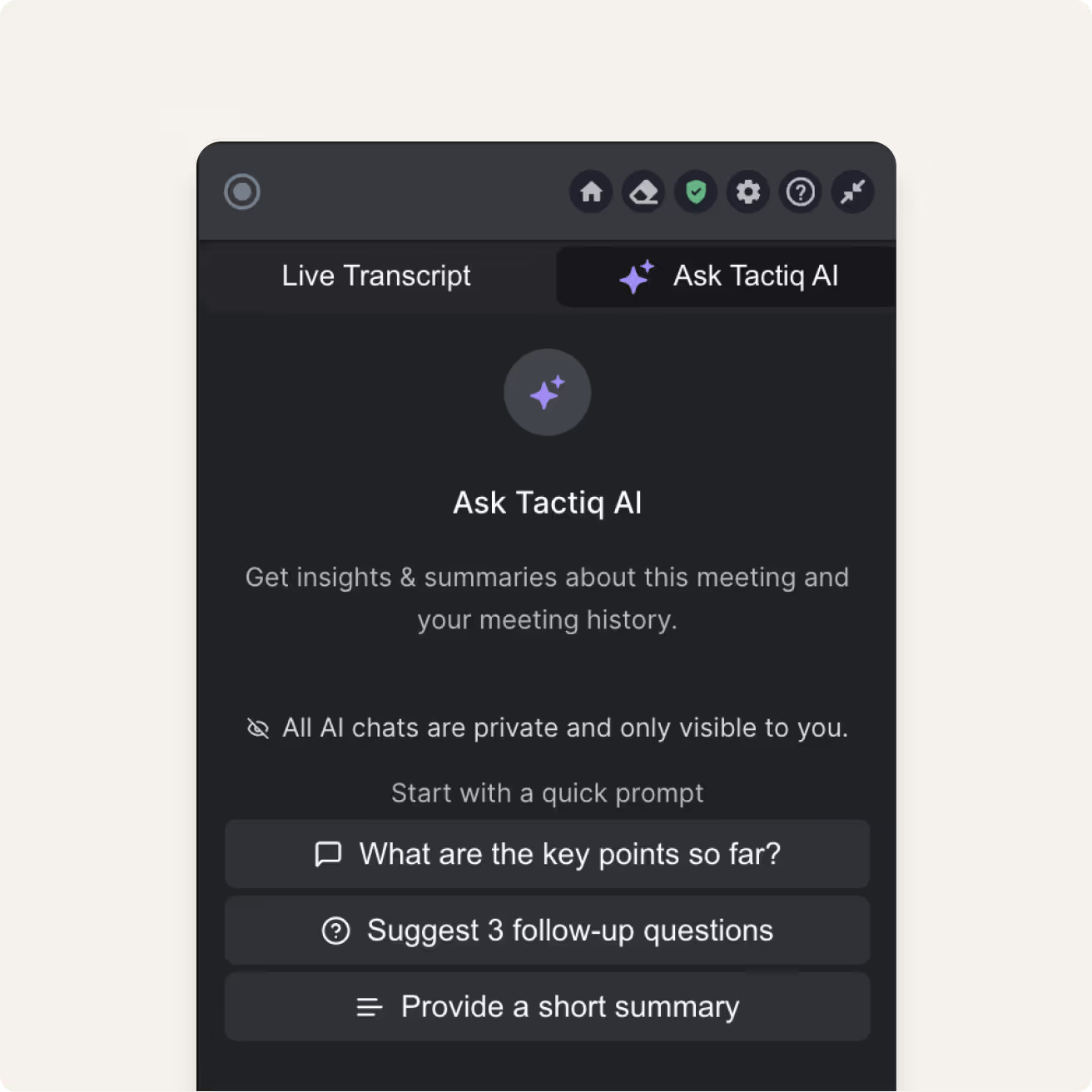Complete Guide to AI Meeting Analytics for More Productive Meetings
June 5, 2024
June 5, 2024
November 4, 2025
November 4, 2025
Relying on memory, incomplete notes, or vague directions can make meetings feel repetitive and unproductive. Even with the best intentions, discussions often end without actionable insights or clear next steps.
Artificial intelligence now changes how teams analyze and act on meeting data. With AI meeting analytics, you can capture every key point, track progress in real time, and turn conversations into meaningful outcomes.
What’s new in AI meeting tools in 2025
AI meeting tools have evolved beyond simple transcription. They now include:
- In-meeting AI chat that lets participants ask questions and get instant answers during discussions.
- Real-time suggestion prompts to clarify points, identify missing context, or generate action items while the meeting is still happening.
- AI-powered anomaly detection that spots unusual patterns in tone, engagement, or topic shifts.
- Smarter integrations with video conferencing and project management tools for better workflow visibility.
These advances make meetings more interactive and data-driven, giving teams the insights they need to make faster, more confident decisions.
In this guide, you’ll learn:
- The biggest challenges that keep meetings from being productive
- How AI meeting analytics improve team collaboration and outcomes
- The key benefits of using AI meeting summary tools
- How in-meeting AI creates a continuous loop of insights from discussion to delivery
What Are the Biggest Obstacles to Conducting an Effective Meeting?

Meetings can still feel like a struggle even with advanced tools. They’re essential for collaboration and decision-making, but often fail to produce valuable insights. Let’s look at the biggest obstacles teams face today.
Reliance on memory
Depending on memory alone leads to confusion. People often recall details differently, which creates inconsistencies in follow-ups and accountability. Without clear, comprehensive meeting notes, ideas fade and tasks get lost.
Incomplete meeting notes
Traditional note-taking can’t keep up with fast-paced discussions. Even dedicated note-takers miss context, tone, or intent behind decisions. These gaps can lead to incomplete records that make it hard to track progress or revisit why certain choices were made.
Lack of clear direction
Meetings without a clear purpose or structure often end without real outcomes. When objectives aren’t set, discussions drift, and participants leave unsure of what to prioritize. A focused agenda and defined action items keep teams aligned on what needs to happen next.
Remote and hybrid meeting fatigue
As more teams work across time zones, remote and hybrid fatigue has become a new barrier. Long hours on video calls drain attention and reduce engagement. This makes iit harder for participants to stay focused and contribute meaningfully.
AI hallucination and data accuracy
AI tools can generate summaries and action points instantly, but they sometimes misinterpret or fabricate information, a problem known as AI hallucination. Relying too heavily on unverified AI-generated notes can lead to confusion or incorrect takeaways. Teams now need to balance automation with human review to ensure accuracy.
Data security and privacy concerns
With the rise of AI meeting assistants, protecting sensitive meeting data has become a priority. Teams want tools that respect privacy, follow security standards, and store transcripts safely. Choosing tools with transparent data policies is key to maintaining trust.
Building trust in AI insights
Trust and transparency remain crucial. Leaders want to understand how insights are generated, not just see the results. Clear visibility into how data is analyzed helps teams build confidence in using AI for decision-making.
How AI Meeting Analytics Can Help Teams Have More Productive Meetings
Modern AI meeting analytics tools can analyze tone, structure, and participation to help create productive meetings with clear, data-driven outcomes. Powered by natural language processing (NLP) and machine learning, these tools capture every key point and convert it into actionable insights teams can use right away.
Real-time suggestion prompts

AI now helps teams stay focused in the moment. With real-time suggestion prompts, participants receive instant guidance such as clarifying a vague statement, summarizing a long discussion, or adding missing context.
💡 Pro tip: Use Tactiq’s In-Meeting AI to get live prompts and instant summaries during your call. It keeps everyone aligned and focused as the meeting unfolds.
Live Q&A and clarifications
Meeting participants no longer have to wait until after the call to get answers. With live AI Q&A, you can ask questions like “What did we agree on for next week?” and get an instant summary from the AI assistant.
See examples of how teams use this feature in In-Meeting AI Questions.
Anomaly detection in meetings
AI analytics tools can now spot unusual trends or engagement drops during meetings. For instance, they can flag when the conversation tone shifts or when certain team members stop participating.
AI-powered insights help leaders address communication issues early, improving inclusivity and collaboration. Over time, anomaly detection supports more balanced and effective discussions.
Analyzing sentiment and participation

AI can interpret the emotional tone of a discussion to identify positive, negative, or neutral sentiment. It also tracks who speaks most often and who contributes less to show imbalances in participation. These insights help teams create fairer conversations and build trust among participants.
Recognizing recurring topics and themes
AI meeting analytics tools analyze transcripts to surface patterns across multiple meetings. They can reveal recurring challenges, ongoing project themes, or frequently unresolved issues. Teams can then prioritize those areas in future meetings for consistent progress. With this data-driven approach, every meeting builds naturally on the last.
Providing data-driven insights for decision-making
Instead of relying on incomplete memory or scattered notes, AI meeting analytics tools deliver clear, structured summaries based on data analysis and historical data. This allows teams to make informed decisions supported by context and facts. Leaders can easily track progress, identify blockers, and plan next steps with confidence.
Main Benefits of Using an AI Meeting Analysis Tool for Your Meetings
AI meeting analysis tools have evolved from simple note-takers into interactive assistants that help teams think, plan, and decide faster. With in-meeting AI, you don’t have to wait until after the call for clarity. Just ask questions, request summaries, or generate action items while the meeting is still happening.
Tactiq is an AI meeting analysis tool with in-meeting AI that works across Google Meet, Microsoft Teams, and Zoom. It acts like a live thought partner in your meeting: ready to summarize discussions, clarify points, and turn ideas into actions in real time.
Here’s how you can use Tactiq’s In-Meeting AI to make meetings more focused and productive.
Identifying key themes and recurring topics

Tactiq’s in-meeting AI helps you pinpoint what matters most as discussions evolve. You can ask it to summarize, restate main points, or identify recurring topics to keep everyone aligned. This reduces repetition and ensures the conversation stays on track.
Sample prompts:
- “Summarize what we’ve discussed so far.”
- “What main ideas have come up more than once in this meeting?”
- “Can you list the key points made in the last 10 minutes?”
Providing actionable insights and follow-ups
Instead of waiting until the meeting ends to assign next steps, Tactiq helps you clarify them in real time. You can ask for task lists, responsible owners, or deadlines based on what’s being discussed. These prompts ensure that every participant leaves knowing exactly what to do next.
Sample prompts:
- “List the action items from this discussion.”
- “Who’s responsible for each task we’ve mentioned?”
- “What deadlines were discussed or implied?”
Explore how it works in Tactiq Action Items.
{{rt_cta_ai-convenience}}
Saving time and reducing manual effort
With in-meeting AI, there’s no need to juggle between taking notes and participating. You can ask Tactiq to record essential points, summarize sections of the discussion, or highlight decisions. Your meeting notes are ready the moment the call ends, saving hours of review later.
Sample prompts:
- “Capture the main takeaways from this section.”
- “Summarize this discussion in two sentences.”
- “Highlight the most important decisions so far.”
Enhancing meeting outcomes and future agendas
Tactiq helps you close meetings with clarity and set up the next one with purpose. You can prompt it to summarize final decisions, suggest follow-up topics, or outline what to discuss next time. This keeps meetings continuous, structured, and goal-oriented.
Sample prompts:
- “Summarize today’s final decisions.”
- “Suggest three topics to revisit in our next meeting.”
- “What should our follow-up agenda include?”
Tactiq’s in-meeting AI helps you act faster, communicate clearly, and turn real-time discussions into actionable plans.
Download the Tactiq Chrome Extension for free and start using in-meeting AI features today.
Transforming Meetings with AI Analytics
AI meeting analytics have evolved beyond note-taking. They now help teams think, decide, and act in real time. With in-meeting AI, you can ask questions, capture insights, and confirm action items before the meeting ends, creating a direct path from discussion to delivery.
Tools like Tactiq’s In-Meeting AI make this possible across Google Meet, Microsoft Teams, and Zoom. You can prompt the AI to summarize key points, identify follow-ups, and suggest next topics while everyone is still on the call.
By using in-meeting AI, teams replace guesswork with clarity and turn every conversation into measurable progress.
FAQs About AI Meeting Analytics
What is meeting analytics?
Meeting analytics uses AI and data analytics to study meeting content, participation, and sentiment. The goal is to uncover insights that improve communication, follow-ups, and overall meeting outcomes.
What are examples of analytics?
Examples include speaker participation tracking, sentiment analysis, recurring topic detection, and follow-up completion rates. These are all part of AI meeting analytics tools that help teams make data-driven decisions.
How do you measure the effectiveness of a meeting?
Teams can measure effectiveness by evaluating engagement, clarity of outcomes, task completion, and progress between meetings. AI tools now automate these insights for better reporting.
What are the 4 stages of analytics?
The four stages are descriptive, diagnostic, predictive, and prescriptive analytics: showing what happened, why, what could happen next, and what actions to take.
What are the benefits of AI-based meeting analytics?
They turn conversations into actionable insights, reduce manual note-taking, improve team alignment, and help leaders make faster, data-driven decisions.
The biggest obstacles are relying on memory, incomplete meeting notes, and a lack of clear direction. These issues cause misunderstandings, missed details, and confusion about next steps, making it hard for you to act on meeting outcomes.
AI meeting analytics analyze sentiment, track speaker participation, and recognize discussion patterns. You gain actionable insights and ensure nothing important is missed, so your meetings lead to clear decisions and follow-up actions.
Tactiq provides live transcriptions, identifies key themes, and generates summaries and action items from your meetings. You save time, avoid manual note-taking, and ensure your team always follows up on critical topics.
AI tools highlight recurring concerns and unresolved issues, helping you allocate resources and address problems before they escalate. This leads to more informed, timely decisions and better project outcomes.
By analyzing past meetings, AI tools suggest topics that need more focus and help you create structured, relevant agendas. You run more efficient meetings, stay on track, and ensure every discussion addresses your team’s most pressing needs.
Want the convenience of AI summaries?
Try Tactiq for your upcoming meeting.
Want the convenience of AI summaries?
Try Tactiq for your upcoming meeting.
Want the convenience of AI summaries?
Try Tactiq for your upcoming meeting.









